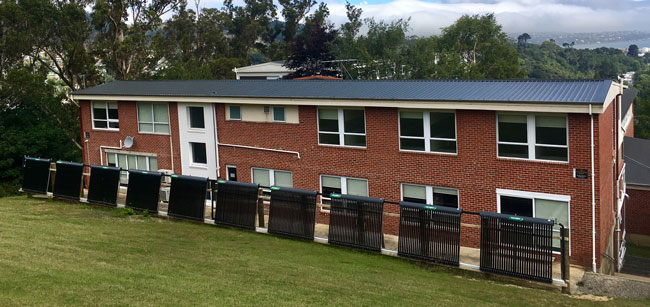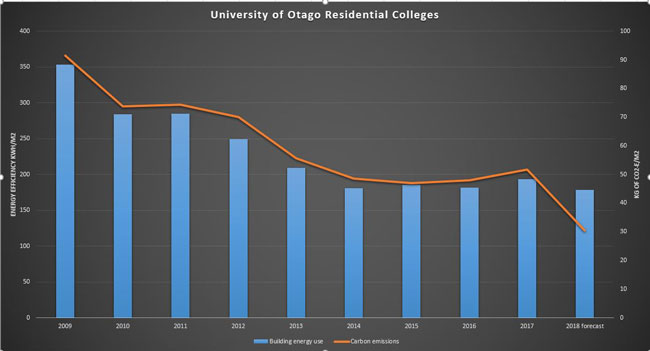
An efficient line-up ... the solar panel 'fence' behind The Priory student accommodation building at Aquinas College, in Gladstone Road, Dalmore, Dunedin.
Energy efficiencies at the University's residential colleges are forecast to save $775,000 annually from this year – and a solar panel 'fence' has already saved Aquinas College more than $4,000 on hot water in a single semester.
The solar panels do not produce electricity, they heat up liquid glycol in pipes and those pipes heat the water, Property Services Division Energy Manager Hans Pietsch and Energy Coordinator Mark Mason say.
Then the water flows into new, larger hot water cylinders that keep more water hot for longer to avoid all electricity use during high-cost winter peaks.
The line of 10 thermal solar panels was installed behind The Priory building last winter, for students in its 34 rooms.
Those panels have a combined surface area of about 36 square metres and can supply 25 kilowatts of heat at peak times – supplying four times more energy than electricity-producing solar panels taking up the same area.
Property Services fitted low-flow showerheads as well, which cut the use of hot water to less than half the previous level.
Now, Aquinas is expecting to need less than 10 per cent of the electricity it used last year to heat water in The Priory – and no electricity during the high-cost winter peaks.
Creating a 'fence' of thermal solar panels was investigated because The Priory's roof was not suitable for solar panels.
Having the panels on the ground means they can be tilted to 75 degrees, to catch the most winter sun possible, without generating too much heat in summer.
The Priory switched to solar hot water heating when its hot water cylinders needed replacing, which reduced the financial impact of the change.
Mr Pietsch and Mr Mason see replacing equipment and renovating buildings as cost-effective opportunities to become more energy efficient, by working with the divisions involved.
Aquinas College Head of College Luke McClelland is proud the colleges are playing their part in helping the University achieve its aim of having zero carbon campuses.
The Property Services Division Energy Team has been tracking the changes at the colleges since 2010 and is predicting that by the end of this year, the colleges will be:
- 35 per cent more energy efficient
- 59 per cent more carbon efficient
Initiatives at the colleges helping to achieve those results include:
- Using a renewable resource, by replacing Carrington's aging coal-fired boiler with a woodchip boiler last month
- Connecting University College to Pioneer Energy's boiler at the Dunedin Energy Centre in Castle Street, as its fuel changes from coal to wood. Hayward, Cumberland and Te Rangi Hiroa already use it for heat
- An ongoing programme – involving Property Services' electrical team – to replace lights with LEDs, and use more sensors to turn lights off and on only as needed
- Fitting low-flow shower heads to reduce water consumption
- Finding double-glazed windows with frames that still provide ventilation in college bedrooms, to prevent them becoming too hot or developing mould
- Adding insulation or topping it up during renovations
- Making existing equipment as efficient as possible. Fine-tuning Arana's coal-fired boiler reduced consumption by 29 per cent. Replacing it with a new wood chip boiler is also being investigated
- Using solar energy to heat the swimming pool at Abbey College, which started about a decade ago
- A close working relationship between the Property Services Division Energy Team and college staff, turning all sorts of issues into opportunities since 2010.

Heading down ... a chart showing energy use at the University's residential colleges since 2009.
The Operations Group focuses on enabling, engaging and providing an amazing experience.
Under enable, the Sustainability Strategic Framework launched last year included these targets:
- Reducing greenhouse gas emissions by 33 per cent by 2020
- Improving energy efficiency by at least 20 per cent by 2025
- Using 100 per cent renewable energy sources by 2030.